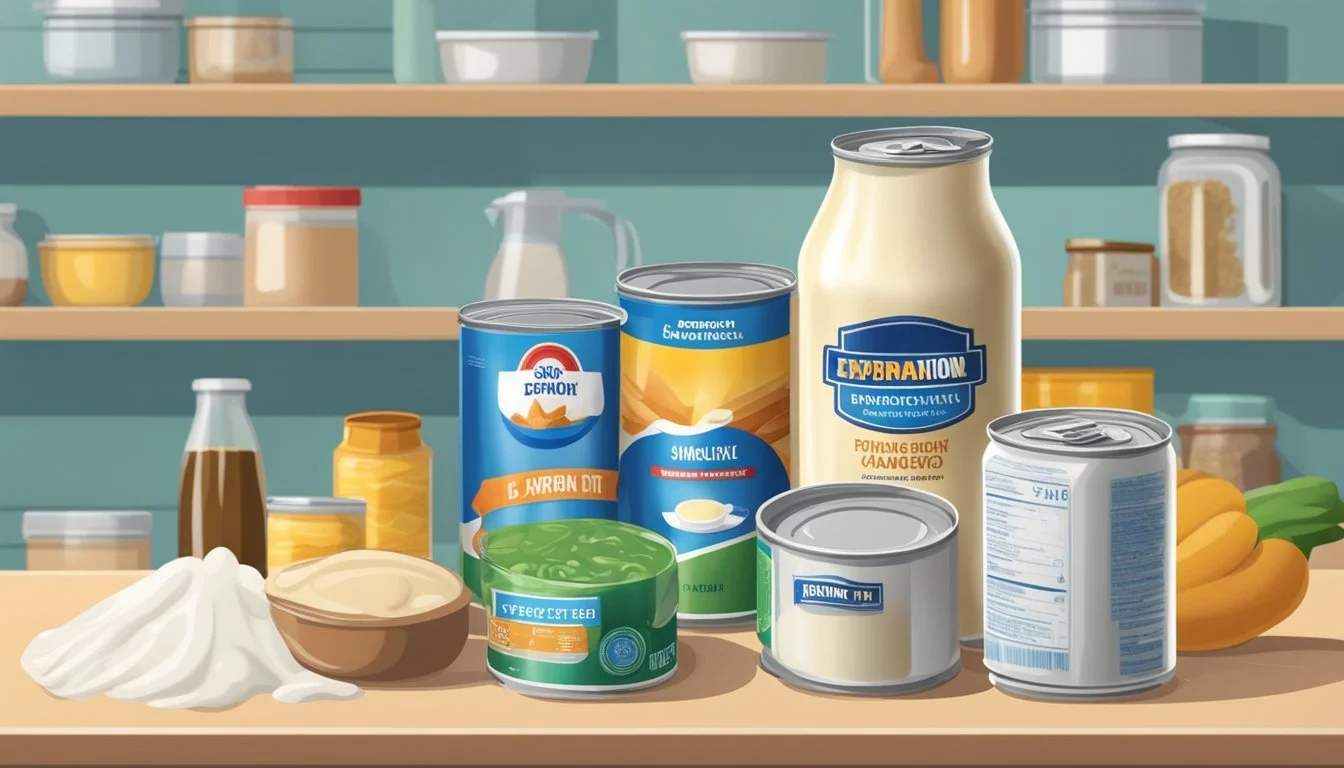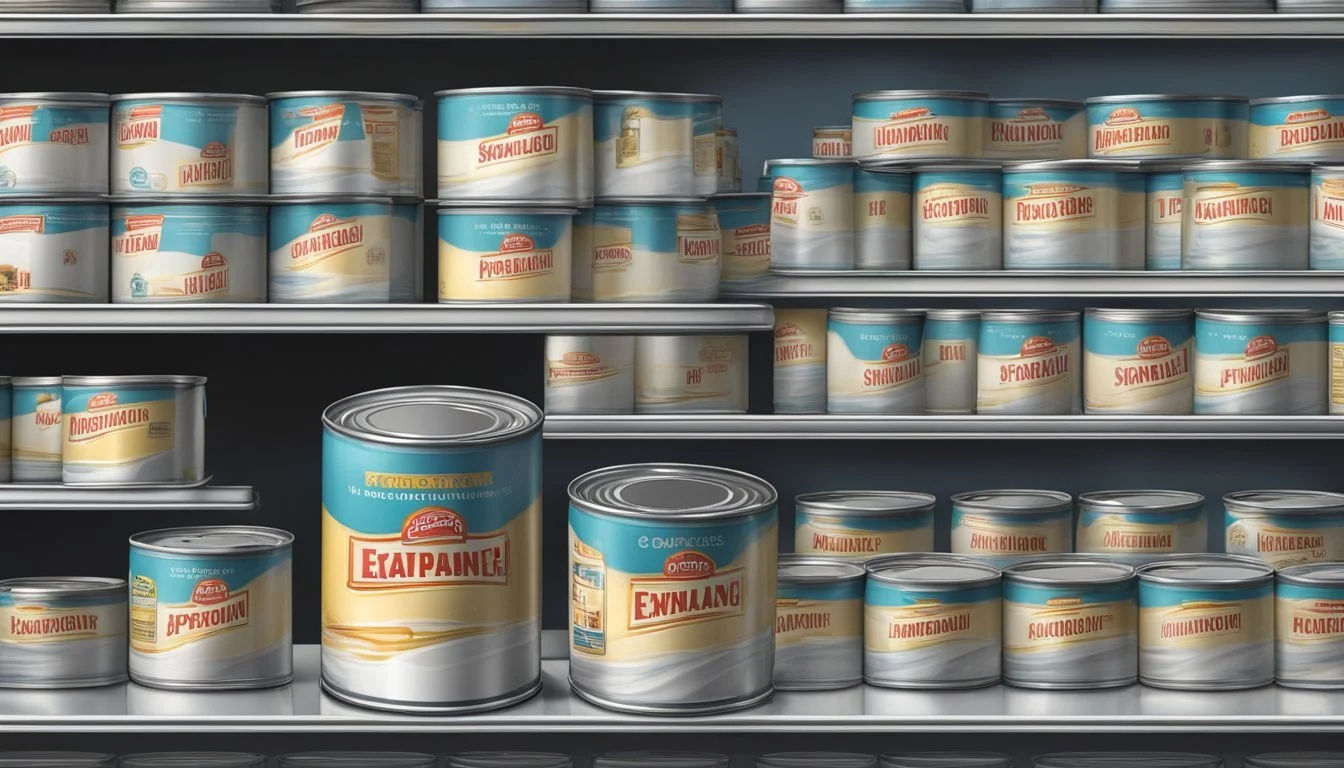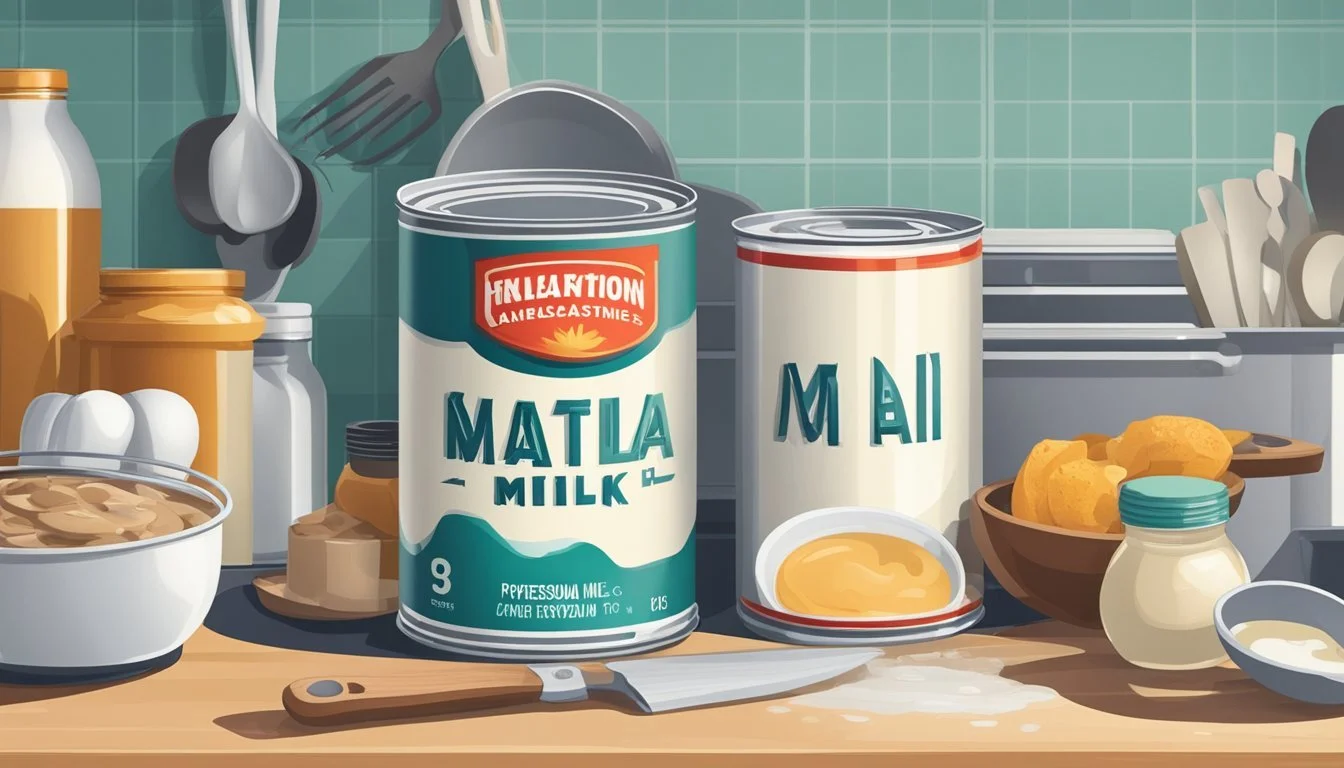Does Canned Evaporated Milk Expire?
Facts You Need to Know
Canned evaporated milk is a versatile kitchen staple, often used in baking and cooking. Despite printed expiration dates, canned evaporated milk can generally be safe to consume beyond these dates. When stored unopened in a cool, dry place, evaporated milk can maintain its quality for up to 18 to 24 months.
A key aspect of its longevity lies in the evaporation process, which removes much of the water content from fresh milk, resulting in a product with an extended shelf life. Even after extended storage, as long as the can remains sealed, undamaged, and the milk shows no signs of spoilage, it can still be used safely.
Once opened, canned evaporated milk should be used within five days and stored in an airtight container in the refrigerator. Paying attention to the condition of the can and storage practices is crucial to ensure its safety and quality.
Understanding Evaporated Milk
Evaporated milk is a shelf-stable dairy product created by removing about 60% of the water content from fresh milk. This process gives it a rich taste and a longer shelf life, making it a popular pantry staple.
Composition and Manufacturing
Evaporated milk consists mainly of milk solids and water, with approximately 60% of the water removed. The milk is heat-processed to evaporate the water content, which also kills any microorganisms present.
The result is a denser, creamier milk product. Vitamins A and D are often added to many types of evaporated milk to enhance its nutritional profile. The heat-processing not only extends the product's shelf life but also changes its flavor, giving it a slightly caramelized taste.
Shelf Life and Expiration Date
Canned evaporated milk is typically good for 12 to 24 months when stored in a cool, stable environment. The cans must be kept undamaged to ensure the milk remains safe to consume.
After the printed expiration date, the milk can still be safe to use if the can shows no signs of damage, rust, or swelling. Once opened, any unused milk should be refrigerated and used within 3 to 5 days. Key storage factors include temperature and light exposure—both should be minimized to preserve the milk's quality.
Proper Storage Practices
Proper storage of canned evaporated milk is essential to maximize its shelf life and maintain its quality. It is important to follow specific guidelines for both unopened and opened cans to ensure the milk remains safe for consumption.
Unopened Cans
Unopened cans of evaporated milk can last up to 18-24 months beyond the printed expiration date when stored correctly. The best storage conditions are a cool, dry place, such as a pantry, away from direct sunlight and heat sources.
Maintaining a stable temperature is vital. Fluctuations can compromise the can's seal and the milk's quality. Avoid storing cans in damp areas or places prone to temperature changes, like garages or attics.
Storing unopened cans at room temperature is recommended. If the can remains sealed and in good condition, the milk inside typically remains safe and usable well beyond the expiration date.
After Opening
Once opened, evaporated milk should be transferred from the original can to a clean, airtight container. This helps prevent contamination and retains the milk's freshness.
Refrigerating the milk immediately after opening is crucial. Use a container with a tight-fitting lid made of glass or plastic. Write the date you opened the can on the container for reference.
Stored in the fridge, opened evaporated milk usually remains fresh for 3-5 days. Check for any signs of spoilage, such as unusual odor or texture, before usage to ensure safety.
The proper storage of both unopened and opened cans of evaporated milk ensures longevity and quality, reducing waste and preserving the milk's usability for your recipes.
Detecting Spoilage
Determining whether canned evaporated milk has spoiled involves checking for specific visual, olfactory, and physical signs. Proper assessment ensures the milk is safe for consumption.
Visual Clues
Several visual indicators can help detect if evaporated milk has gone bad. Discoloration is a prime sign; fresh evaporated milk should have a consistent creamy color. A darkened or uneven color indicates spoilage.
Inspect the can for any bulging, dents, or rust. A bulging can signifies gas production from bacterial activity, which is a major red flag. Mold inside the can or on the surface of the milk is another definitive sign of spoilage.
Keep an eye out for signs of separation in the milk. While some separation is natural, excessive separation that doesn't mix back together after shaking the can points to possible spoilage.
Smell and Taste
The smell is a strong indicator of evaporated milk's condition. If the milk emits an off odor or sour smell when the can is opened, it suggests spoilage. Fresh evaporated milk should have a mild and slightly sweet scent.
Tasting a small amount can also help, though it's less advisable if other signs of spoilage are present. A metallic or sour taste signals that the milk is no longer good for consumption. Always rely on smell first before resorting to taste.
Avoid tasting if the milk shows significant visual changes or smells strongly off. Trust your senses in this assessment.
Physical Changes
Physical changes in evaporated milk can indicate spoilage. Changes in texture are notable; fresh evaporated milk has a smooth and consistent texture. Lumps or clumps suggest that the milk has spoiled.
Check if the milk feels unusually thick or thin. Spoiled milk may exhibit a thicker, gelatinous consistency, or become excessively watery.
Shake the can before pouring. If it doesn't mix well or appears chunky, these physical changes are signs that the milk should not be consumed. Physical changes often accompany visual and olfactory indicators, completing the assessment for spoilage.
Effect of Spoilage
Spoiled canned evaporated milk poses significant risks related to health and quality. Key points include potential foodborne illnesses and noticeable changes in texture and flavor.
Health Implications
Consuming expired evaporated milk may lead to foodborne illnesses. It can harbor harmful bacteria such as Salmonella and E. coli. These pathogens can cause severe symptoms like nausea, vomiting, and diarrhea. Mold can also form, producing toxins that are dangerous to consume.
Proper food safety measures are crucial to avoid these risks.
Regularly check for signs of spoilage, including unusual smells and visible mold. Always store evaporated milk in a cool, dry place and use it within the recommended timeframe.
Quality Deterioration
Spoilage affects the quality of evaporated milk. Common indicators include changes in texture, such as curdling or separation. The color may also darken, and the milk might develop a sour smell.
Upon opening, using sensory checks like smelling and stirring can help determine if the product has deteriorated. A spoiled can will taste off and should not be consumed.
To maintain quality, transfer any unused milk to an airtight container and refrigerate it, consuming it within five days. Proper storage conditions and timely consumption are essential for preserving the milk's intended flavor and texture.
Extending Shelf Life
Preserving evaporated milk involves proper storage techniques and understanding how freezing can maintain its quality beyond the usual expiration date.
Freezing Techniques
Freezing evaporated milk can significantly extend its shelf life. Transfer the milk into an airtight container, leaving some space at the top as the milk will expand when it freezes. An ice cube tray is also a good method, allowing the milk to be portioned out and used as needed.
When storing in the freezer, label the containers with the date of freezing. Frozen evaporated milk can last for up to three months. When ready to use, thaw the milk in the refrigerator. Avoid leaving it out at room temperature to maintain freshness and reduce the risk of bacterial growth.
Optimal Conditions
Storing evaporated milk in optimal conditions helps maintain its quality. Unopened cans should be kept in a cool, dry place, away from direct sunlight. Pantries work well for this purpose. Once opened, refrigerate the milk in an airtight container to prevent contamination and retain freshness.
Always check for signs of spoilage before use, such as off-smells or changes in texture. Knowing how long evaporated milk lasts in various conditions can help make the most of its shelf life. Taking these steps can ensure that the milk stays safe and usable for a longer period.
Utilization in Cooking
Canned evaporated milk is a versatile ingredient with many useful applications. It works well as both a milk alternative and in various creative recipes.
As a Milk Alternative
Evaporated milk can be used as a substitute for regular milk in many recipes, particularly in baking and cooking. Mix equal parts evaporated milk and water to replace fresh milk in cakes, cookies, and breads. This substitution offers a richer flavor and creamier texture.
In coffee, evaporated milk adds a creamy consistency without the need for additional sweeteners. For soups and sauces, its thicker consistency enhances the dish while reducing the need for heavy cream.
Using evaporated milk in smoothies can provide a creamier consistency compared to regular milk. This method is helpful for making thick, rich desserts like custards and flans.
Creative Uses
Besides being a straightforward milk alternative, evaporated milk can be creatively used in various dishes. It makes an excellent base for soups, delivering a creamy texture without extra fat. Combine it with broth and vegetables for a velvety soup.
In desserts, evaporated milk helps achieve a smooth and creamy texture. Use it for making pie fillings, puddings, and ice creams. It’s also ideal for whipped toppings when you need a stable and airy finish.
For leftover evaporated milk, consider using it in savory dishes like pasta sauces or casseroles. This can help minimize waste while enhancing the richness of the meal.
Labeling and Regulation Overview
Manufacturers of canned evaporated milk follow strict guidelines to ensure both safety and quality of the product. A key element of this is the date of manufacture and the best-by date that are printed on the packaging.
Best-by Date
The best-by date indicates the period during which the product retains its best flavor and quality. It is typically up to 18 to 24 months from the date of manufacture when stored properly.
Packaging and Storage
Proper packaging is essential. Cans must be sealed securely to prevent contamination. Storage conditions—cool, dry places—are important to maintain the milk's quality.
Expiration Date
The expiration date may also be indicated, advising consumers of the last date the product is expected to remain safe to consume. The product may still be safe beyond this, but quality might diminish.
Regulation
In many countries, food products, including evaporated milk, fall under food safety regulations established by governmental bodies. These regulations mandate the proper labeling of dates and storage instructions.
Following the provided guidelines ensures the product remains safe and maintains its quality up to the date printed, and sometimes beyond. Properly labeled products build consumer trust and comply with regulatory standards.
Disposal and Environmental Considerations
Canned evaporated milk, although widely useful, does not last indefinitely. When it becomes expired or unusable, proper disposal is key to environmental sustainability.
Expired evaporated milk should be discarded in a responsible manner. Pour the contents into a compost pile or, if unavailable, down the sink while ensuring it is thoroughly diluted with water.
Recycling is crucial for the aluminum or steel cans used for packaging evaporated milk. Always rinse the can to remove any leftover residue before placing it in a recycling bin. This helps prevent contamination of recyclable materials.
Here's a quick guide to follow:
Action Instructions Discard Milk Pour into compost or dilute in water before disposal in sink Recycle Can Rinse thoroughly to remove residue, then place in recycling bin
Cans can significantly contribute to waste if not recycled properly. Recycling these materials reduces the need for raw material extraction, decreasing the overall environmental footprint. It also conserves natural resources and energy.
Proper disposal and recycling of expired evaporated milk and its cans foster better environmental practices. By following these steps, everyone can contribute to a more sustainable environment.






